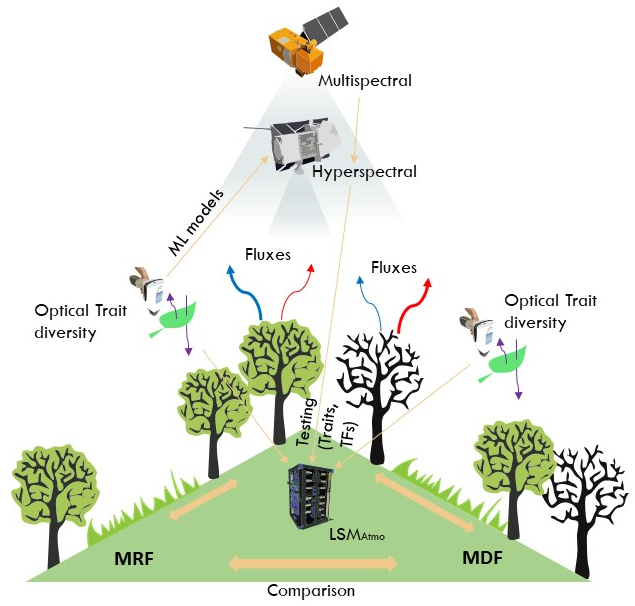A1 Changes of water and carbon fluxes in mountain wet and dry forests under environmental changes - observations, area-wide remote sensing and LSMAtmo. [funded by DFG]
PI(s) for this project:
Prof. Dr. Katja Trachte
Prof. Dr. Jörg Bendix
Abstract:
 The main aim of the project is to investigate the resistance of water and carbon fluxes at the atmosphere-ecosystem interface along an altitudinal and climatic gradient in the southern Andes of Ecuador under climate and land use changes, mediated by changes in functional traits and biological processes. While the focus of the first phase was on the mountain rain forest (MRF), we will now extend our work to the Tumbesian mountain dry forest (MDF) around the Laipuna reserve. The project is responsible for LSMAtmo as part of the coupled HUMBOL-TD (Hydroatmo Unified Model of Biotic interactions and Local Trait Diversity) model framework, here particularly for the new area-wide implementation of LSMAtmo for the agreed MDF and MRF catchments, and the synthesis work regarding the target function water fluxes. For the entire program, our Eddy Covariance (ECov) measurements are delivering central test data for the simulated target functions on the plots, the hyperspectral field survey provides optical data for model parameterization of the MDF and the climate data will be used as co-variates for the response-effect framework (REF) or to force the model. For area-wide model parameterization and testing of HUMBOL-TD, we will provide gridded PFT maps, gridded layers of the functional traits (such as SLA, WSG) derived from hyper- and multispectral remote sensing and machine learning to test the simulated traits of LSMBio, and gridded data to evaluate the target function water fluxes for both, the jointly selected MRF and MDF catchments. Beyond our contribution for testing the joint hypotheses, we will in particular analyze the atmospheric and soil energy, water and carbon fluxes obtained by ECov and soil gas chamber measurements to derive ecosystems carbon and water budgets over the natural forest in comparison to the anthropogenic replacement systems, and its contribution to the resistance of the target functions under different seasonality (MDF versus MRF), climate extremes and future climate change. Furthermore, we will comprehensively analyze the role of optical trait changes (leaf albedo, transmittance) on the latent heat flux with HUMBOL-TD. We believe that the recently postulated NIR vegetation darkening effect under climate change and its effects on heat fluxes must be revisited by also considering leaf transmittance. To test this, we will include optical trait diversity into LSMAtmo.
The main aim of the project is to investigate the resistance of water and carbon fluxes at the atmosphere-ecosystem interface along an altitudinal and climatic gradient in the southern Andes of Ecuador under climate and land use changes, mediated by changes in functional traits and biological processes. While the focus of the first phase was on the mountain rain forest (MRF), we will now extend our work to the Tumbesian mountain dry forest (MDF) around the Laipuna reserve. The project is responsible for LSMAtmo as part of the coupled HUMBOL-TD (Hydroatmo Unified Model of Biotic interactions and Local Trait Diversity) model framework, here particularly for the new area-wide implementation of LSMAtmo for the agreed MDF and MRF catchments, and the synthesis work regarding the target function water fluxes. For the entire program, our Eddy Covariance (ECov) measurements are delivering central test data for the simulated target functions on the plots, the hyperspectral field survey provides optical data for model parameterization of the MDF and the climate data will be used as co-variates for the response-effect framework (REF) or to force the model. For area-wide model parameterization and testing of HUMBOL-TD, we will provide gridded PFT maps, gridded layers of the functional traits (such as SLA, WSG) derived from hyper- and multispectral remote sensing and machine learning to test the simulated traits of LSMBio, and gridded data to evaluate the target function water fluxes for both, the jointly selected MRF and MDF catchments. Beyond our contribution for testing the joint hypotheses, we will in particular analyze the atmospheric and soil energy, water and carbon fluxes obtained by ECov and soil gas chamber measurements to derive ecosystems carbon and water budgets over the natural forest in comparison to the anthropogenic replacement systems, and its contribution to the resistance of the target functions under different seasonality (MDF versus MRF), climate extremes and future climate change. Furthermore, we will comprehensively analyze the role of optical trait changes (leaf albedo, transmittance) on the latent heat flux with HUMBOL-TD. We believe that the recently postulated NIR vegetation darkening effect under climate change and its effects on heat fluxes must be revisited by also considering leaf transmittance. To test this, we will include optical trait diversity into LSMAtmo.

